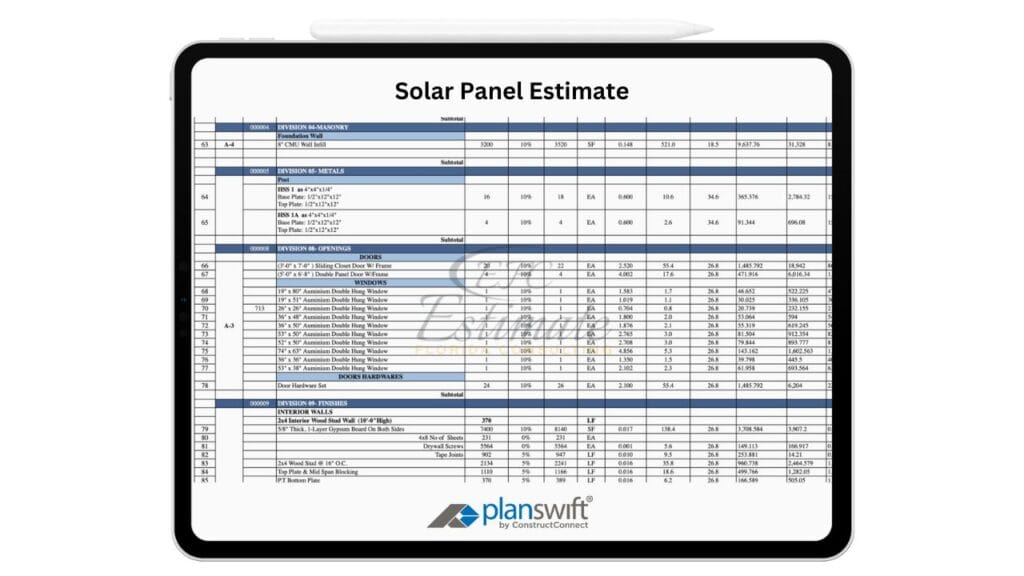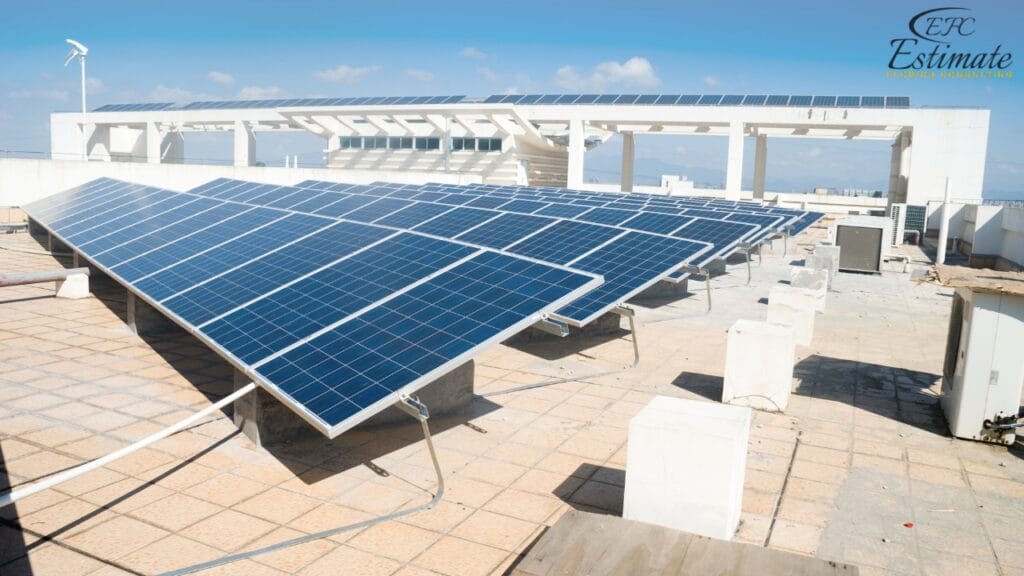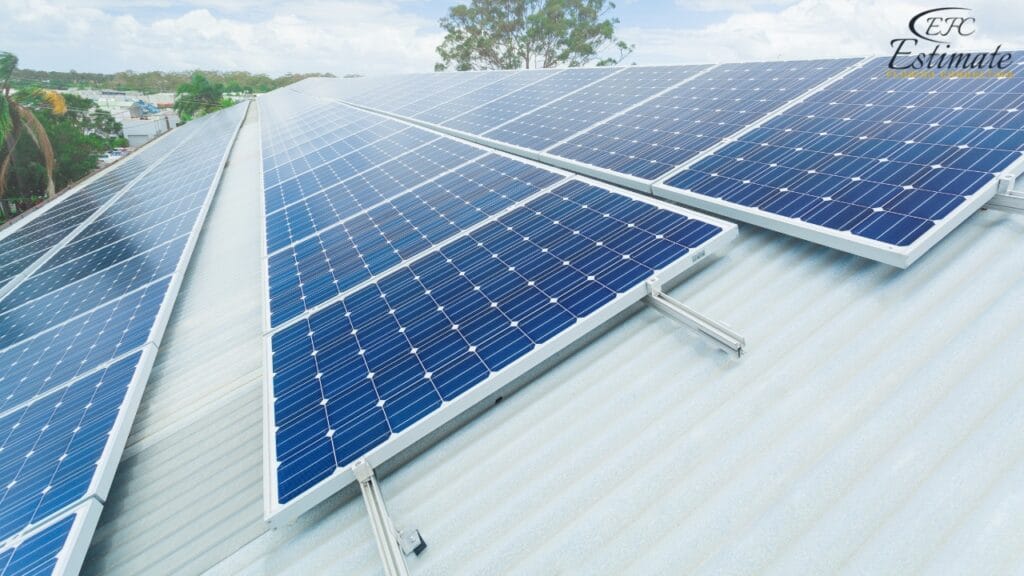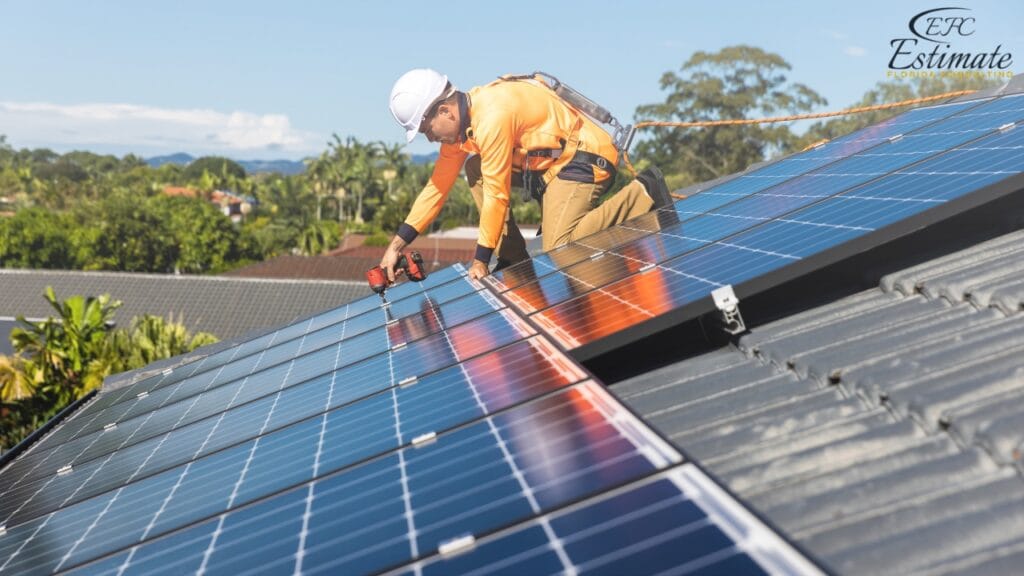90% More Chances to Win Projects With Our Estimate!
- Multi-Family Building
- Hotel Building
- Hospital Building
- Warehouse Building
- School & University Building
- High-Rise Building
- Shopping Complex
- Data Center Building

Solar energy adoption is on the rise in Florida due to the state’s abundant sunshine, increasing utility costs, and growing awareness of renewable energy’s environmental benefits. Homeowners, developers, and contractors are increasingly installing solar systems. However, there are situations where panels need to be removed for roof repairs, upgrades, or relocation. Understanding the complete cost of solar panel removal and reinstallation is vital for budgeting and avoiding unexpected expenses.

Several factors influence the cost of removing and reinstalling solar panels in Florida. These costs can vary based on the size of the system, labor requirements, materials needed, and additional fees such as permits and inspections.
Cost Factor | Average Cost (Low) | Average Cost (High) |
Labor Costs (per hour) | $60 | $120 |
Material Costs | $240 | $600 |
Permit and Inspection Costs | $120 | $360 |
Disposal Fees (per panel) | $60 | $120 |
Labor is one of the largest cost components in solar panel removal and installation. In Florida, labor costs typically range from $60 to $120 per hour, depending on the complexity of the project and the expertise of the contractors involved. Labor costs will also depend on the size of the system and the number of panels that need to be removed or installed. Typically, removing and reinstalling a small system may require a few hours, while larger systems can take a full day or more.
Material costs can include the replacement of mounting brackets, screws, wiring, and sometimes the inverter, depending on the condition of the components. On average, material costs for solar panel reinstallation range from $240 to $600. If additional materials are required to repair damaged equipment or if upgrading to a newer system, these costs can increase substantially.
Permits are required for solar panel removal and reinstallation in Florida, as the local building department needs to ensure the project complies with state and local building codes. Permit fees can range from $120 to $360, and inspection fees may also be necessary to ensure the system is functioning correctly after reinstallation. This step is crucial for safety and to maintain compliance with any tax credits or incentives.
Other potential costs include disposal fees for old or damaged solar panels, temporary storage fees if the panels need to be stored offsite, and costs for upgrading electrical systems to accommodate a more modern solar system. These additional fees can add hundreds of dollars to the overall cost of the project.
Here’s a detailed look at the typical costs involved in removing and reinstalling solar panels in Florida.
The cost to remove solar panels varies based on the size of the system and the number of panels. Larger systems will require more labor and time to remove, increasing the overall cost. Here’s a breakdown of removal costs for various system sizes:
System Size (kW) | Number of Panels | Removal Cost (Low) | Removal Cost (High) |
5 kW | 15–20 panels | $600 | $1,200 |
7 kW | 20–28 panels | $900 | $1,800 |
10 kW | 28–40 panels | $1,200 | $2,400 |
Reinstalling solar panels also requires a detailed process, including reconnecting the system to the electrical grid. Installation costs depend on the size of the system and the complexity of the installation. On average, the cost of reinstallation ranges from $1,800 to $6,000, with additional costs for new materials if needed.
System Size (kW) | Number of Panels | Installation Cost (Low) | Installation Cost (High) |
5 kW | 15–20 panels | $1,800 | $3,600 |
7 kW | 20–28 panels | $2,500 | $5,000 |
10 kW | 28–40 panels | $3,000 | $6,000 |
With the growing trend of energy storage systems, many homeowners are opting for battery storage solutions when reinstalling solar panels. These batteries allow you to store excess energy generated during the day for use during the night or in case of power outages. Battery storage can add significant costs to the overall solar system but also increases energy independence.
Battery storage costs depend on the type and capacity of the battery. For instance, the popular Tesla Powerwall costs between $12,000 and $18,000 installed, depending on system size and configuration. Other brands may range from $8,000 to $20,000, with installation costs included. The installation of a battery storage system generally requires an inverter upgrade, adding to the cost of the solar panel reinstallation.

Battery Capacity (kWh) | Battery Cost (Low) | Battery Cost (High) |
5 kWh | $8,000 | $12,000 |
10 kWh | $12,000 | $18,000 |
15 kWh | $16,000 | $20,000 |
Solar panels have a long lifespan but may require disposal if they become damaged or obsolete. Proper disposal is essential to avoid environmental hazards, as some panels contain hazardous materials. The cost of disposing of solar panels depends on the recycling facility and the panel type.
In Florida, disposal costs range from $60 to $120 per panel. This cost includes safe removal, transportation, and recycling of the panels. Some contractors offer disposal as part of their service, while others may charge an additional fee, so it’s essential to clarify these costs upfront with your solar contractor.
Number of Panels | Disposal Cost (Low) | Disposal Cost (High) |
10 Panels | $600 | $1,200 |
20 Panels | $1,200 | $2,400 |
30 Panels | $1,800 | $3,600 |

Solar panels may need to be removed for various reasons. The need for removal doesn’t always mean the end of solar energy usage; in fact, it’s often a step toward system improvements or property maintenance.
One of the most common reasons for solar panel removal is roof repair or replacement. Solar panels must be removed before any roofing work can begin. After the roof is repaired or replaced, the panels can be reinstalled. Removing and reinstalling the panels can add to the overall cost of roof repairs, making it essential to budget for both roofing and solar services.
As solar technology advances, some homeowners may opt to upgrade their systems to newer, more efficient panels. Newer panels can provide better energy production and reduce energy bills further. Upgrading also may involve changing the inverters, wiring, or mounting systems, all of which contribute to the cost of the project.
When moving to a new home, some homeowners prefer to bring their solar panels with them. While this is possible, the removal, transportation, and reinstallation process can be costly and time-consuming. In many cases, it’s more economical to leave the solar system in place and install a new system in the new home, especially considering the increasing efficiency of modern solar panels.
Even though solar systems are low-maintenance, they may occasionally require repairs or maintenance, especially as the system ages. This could include repairing the inverter, replacing damaged wiring, or fixing faulty connections. Removing panels to access components may also be necessary during such repairs.
Selecting the right contractor for your solar panel removal and installation is crucial to ensuring a smooth process and avoiding unnecessary costs. The contractor should be licensed, insured, and have experience working with solar systems. When vetting a contractor, consider the following:
It’s also a good idea to compare quotes from multiple contractors to ensure you’re getting a fair price for the work. In Florida, where solar projects are common, many reputable contractors offer competitive pricing and package deals that can help reduce the overall cost.
While some homeowners may be tempted to take the DIY route for solar panel removal and installation, this is generally not recommended due to the complexity of the systems and the potential risks involved. Solar panels are connected to electrical systems that require specialized knowledge to handle safely. Additionally, removing and reinstalling panels improperly can void warranties and lead to expensive repairs.
Hiring a professional ensures that the job is done safely, correctly, and in compliance with local codes and regulations. The cost of hiring a contractor is an investment in protecting your solar system and the structural integrity of your home.

Solar panel removal and installation projects require proper permits and adherence to local building codes. Homeowners need to apply for a building permit from their local building department before starting the project. This process ensures that the system complies with safety standards and regulations.
After reinstallation, an inspection is usually required to verify that the system is functioning properly and safely. Some counties in Florida also have additional regulations related to solar energy, so it’s crucial to check with your local authorities before proceeding.
Permitting costs can range from $120 to $360, depending on the county and the complexity of the project. The contractor usually handles the permitting process, but homeowners should be aware of the requirements to avoid delays.
Florida offers several incentives and tax credits that can significantly reduce the cost of solar panel removal, reinstallation, and upgrades. Homeowners and businesses installing solar panels are eligible for the Federal Solar Investment Tax Credit (ITC), which offers a 30% credit on the total system cost. This applies to both new installations and major system upgrades, including reinstallation after removal.
Additionally, Florida provides a Property Tax Exemption for solar energy systems, meaning the value added by the solar panels won’t increase your property taxes. Florida also has a Sales Tax Exemption for solar energy equipment, allowing homeowners to save an additional 6% on the purchase of solar panels, inverters, and other equipment.
Taking advantage of these incentives can save homeowners thousands of dollars on their solar projects, making it a worthwhile investment even when factoring in removal and reinstallation costs.
The future of solar energy in Florida looks bright, with continued advancements in technology making solar systems more efficient and affordable. Some trends shaping the industry include:
With these trends in mind, homeowners considering solar panel installation or upgrades should be prepared for future innovations that could further increase their system’s efficiency and return on investment.
Solar panels are devices that convert sunlight into electricity using photovoltaic (PV) cells. These cells capture photons from sunlight and convert them into direct current (DC) electricity, which is then converted to alternating current (AC) by an inverter to be used in homes. Solar panels are durable, with most systems designed to last 25 to 30 years with minimal maintenance. While initial installation can be costly, solar panels offer significant long-term savings by reducing reliance on the traditional energy grid.
The three primary types of solar panels available for residential and commercial use include:

Solar panel removal and installation are significant investments for homeowners and businesses in Florida. The costs can vary widely depending on factors like labor, materials, and permits, but with the right planning and contractor, these projects can lead to long-term savings and environmental benefits. Understanding the total costs involved and taking advantage of incentives like tax credits can make solar energy more accessible and affordable. Whether you’re upgrading an existing system, repairing your roof, or relocating your solar panels, this guide provides a comprehensive overview to help you navigate the process.
Solar panels may need to be removed and reinstalled for several reasons, including roof repairs or replacement, system upgrades to newer technology, moving to a new home, or performing necessary maintenance and repairs on the solar system itself.
The cost to remove solar panels depends on the size of the system. For instance, removing a 5 kW system (15–20 panels) can cost between $600 and $1,200. Larger systems, such as a 10 kW system (28–40 panels), can cost between $1,200 and $2,400.
Labor costs in Florida typically range from $60 to $120 per hour, depending on the complexity of the job and the contractor's experience. Labor costs are a significant part of the total expense, especially for larger systems or more complex projects.
Reinstalling solar panels can cost between $1,800 and $6,000, depending on the size of the system. For example, a 5 kW system may cost between $1,800 and $3,600 to reinstall, while a 10 kW system could range from $3,000 to $6,000.
Yes, there are several additional fees to consider, such as material costs ($240–$600), permit and inspection fees ($120–$360), and disposal fees for old or damaged panels ($60–$120 per panel). It's essential to budget for these hidden costs to avoid surprises.
Permit and inspection costs cover the approval from local authorities to ensure the project complies with building codes. These fees can range from $120 to $360 and are necessary to maintain safety standards and any tax incentives.
Yes, if your solar panels need to be stored during roof repairs, you may incur storage fees. It's a good idea to check with your contractor if temporary storage is included in the overall cost or charged separately.
In Florida, disposal costs for old or damaged panels range from $60 to $120 per panel. Proper disposal is crucial for environmental safety, as some panels contain hazardous materials.
Upgrading your solar panels during reinstallation is a good opportunity to take advantage of newer technology. Newer panels are more efficient and can lower energy bills. However, upgrading may increase costs due to the need for new materials like inverters or mounting systems.
Yes, many homeowners choose to install battery storage systems to store excess energy. Battery storage systems like the Tesla Powerwall can cost between $8,000 and $20,000, depending on the capacity and installation complexity.
At Estimate Florida Consulting, we offer detailed cost estimates across all major trades, ensuring no part of your project is overlooked. From the foundation to the finishing touches, our trade-specific estimates provide you with a complete and accurate breakdown of costs for any type of construction project.

We take pride in delivering accurate, timely, and reliable estimates that help contractors and builders win more projects. Our clients consistently praise our attention to detail, fast turnaround times, and the positive impact our estimates have on their businesses.
Estimate Florida Consulting has helped us win more bids with their fast and accurate estimates. We trust them for every project!

Submit your project plans, blueprints, or relevant documents through our online form or via email.
We’ll review your project details and send you a quote based on your scope and requirements.
Confirm the details and finalize any adjustments to ensure the estimate meets your project needs.
Receive your detailed, trade-specific estimate within 1-2 business days, ready for your project execution.

561-530-2845
info@estimatorflorida.com
Address
5245 Wiles Rd Apt 3-102 St. Pete Beach, FL 33073 United States
561-530-2845
info@estimatorflorida.com
Address
5245 Wiles Rd Apt 3-102 St. Pete Beach, FL 33073 United States
All copyright © Reserved | Designed By V Marketing Media | Disclaimer